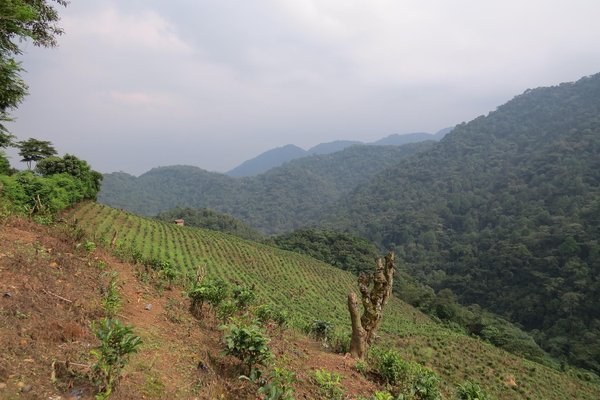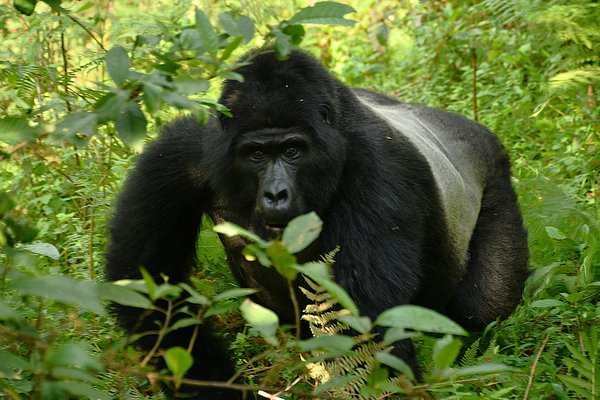Uganda
Bwindi Impenetrable National Park
Bwindi Impenetrable National Park protects a floristically diverse tropical rainforest, inhabited by almost half the world's population of mountain gorillas.
The property is a remnant of a much larger forest, and lies at the intersection of three ecological zones. Due to its altitudinal range of 1,160-2,706m it has exceptional diversity and richness in species, notably regarding trees, butterflies and birds.
Community Perspective: Bwindi is the most accessible place to see mountain gorillas, and several access points provide 1-hr visits to habituated groups of gorillas. It can be a tough hike to reach them.
Site Info
Official Information
- Full Name
- Bwindi Impenetrable National Park (ID: 682)
- Country
- Uganda
- Status
-
Inscribed 1994
Site history
History of Bwindi Impenetrable National Park
- 1994: Inscribed
- Inscribed
- Type
- Natural
- Criteria
- vii
- x
Links
- UNESCO
- whc.unesco.org
- Official
-
- ugandawildlife.org — Uganda Wildlife Authority
All Links
UNESCO.org
- whc.unesco.org — whc.unesco.org/
Official Website
- ugandawildlife.org — Uganda Wildlife Authority
News Article
- Sept. 27, 2025 theguardian.com — Mountain gorillas are back from the brink. But what happens if they run out of room?
- June 12, 2020 bbc.com — Rafiki, Uganda's rare silverback mountain gorilla, killed by hunters
- Dec. 20, 2016 monitor.co.ug — Ndahura, Bwindi's dominant male gorilla dies falling off a tree branch
- Feb. 1, 2010 gadling.com — Uganda has started work on habituating another mountain gorilla group to humans in order to expand safaris in its famous Bwindi Impenetrable National Park
- April 22, 2007 sciencedaily.com — The most recent census of mountain gorillas in Uganda's Bwindi Impenetrable National Park--one of only two places in the world where the rare gorillas exist--has found that the population has increased by 6 percent since the last census in 2002.
Community Information
- Community Category
- Wildlife habitat: Fauna
- Wildlife habitat: Flora
Travel Information
High entrance fees
Recent Connections
-
Perfect Inscriptions
1994 -
Honey Collection
"Non-timber forest produce, notably hon… -
Centres of Plant Diversity
Af25 Bwindi (Impenetrable) Forest - "Th…
Connections of Bwindi Impenetrable National Park
- Geography
-
-
On National Border
On DRC border
-
- Ecology
-
-
Chimpanzee habitat
-
Over 300 bird species
"At least 350 species of birds have been recorded" (IUCN Outlook 2020) -
Refugium
"believed to be a Pleistocene refugium, the property is a biodiversity hotspot with possibly the greatest number of tree species for its altitude in East Africa. It is also host to a rich fauna including a number of endemic butterflies and one of the richest mammalian assemblages in Africa". (UNESCO)See whc.unesco.org
-
Virgin Forests
Bwindi Impenetrable Forest is a large primeval forest (wiki) -
Rainforests
-
Elephants
African elephant -
Gorilla habitat
Mountain gorilla (Bwindi gorilla); has habituated groups -
Strepsirrhini
dusky bushbaby, dwarf bushbaby -
Otters
Congo clawless otter (UNEP-WCMC)
-
- Damaged
-
-
Terrorist Attacks
Rwandan rebels slaughtered eight foreign tourists after they were abducted from Bwindi NP (March 1999)
-
- World Heritage Process
-
-
Perfect Inscriptions
1994 -
First inscriptions
Uganda: two inscriptions in 1994, with Bwindi Impenetrable National Park as the lowest number
-
- Human Activity
-
-
Indigenous groups expelled
Batwa. “The establishment in 1991 of Bwindi and Mgahinga forests as national parks resulted in the permanent eviction and exclusion of the Batwa from their homeland” (WHS-IPR) -
Pygmy Peoples
"The area was declared an animal sanctuary in 1964, when Batwa were pressurized to leave, and gazetted as national park in 1991, when Batwa communities were finally forcibly expelled along with other neighbouring communities involved in agriculture and other forms of forest exploitation" -
Honey Collection
"Non-timber forest produce, notably honey, medicinal plants and basketry materials, make an important contribution to local livelihoods and these products may now be taken from designated zones under the terms of community-use" (IUCN Outlook 2020)See www.bwindi.org
-
- WHS on Other Lists
-
-
World Heritage Forest Programme
-
Centres of Plant Diversity
Af25 Bwindi (Impenetrable) Forest - "The property has the highest diversity of tree species (over 200 species including 10 endemics) and ferns (some 104 species) in East Africa" -
WWF Global 200
Terrestrial, Tropical and Subtropical Moist Broadleaf Forests: (7) Albertine Rift Montane ForestsSee web.archive.org
-
Biodiversity hotspot
Eastern Afromontane
-
- Timeline
-
-
Late Pleistocene
"most of nowadays forests are not further than 12,000 years old, Bwindi's vegetation has been weaving itself into tangles over 25,000 years.... Bwindi acted as Pleistocene refugium and it was able to protect the jungle during the ice age when Africa didn't have such dense vegetation cover. It served as a water tower for most of the wildlife species that relied on the forest unlike other areas that didn't have any forest or vegetation cover"
-
- Visiting conditions
-
-
High entrance fees
800 US dollar (1 day gorilla permit, 2025) -
Unusual Entry Requirements or Restrictions
Visitors to the Gorillas have to state that they are not suffering from a cold or stomach upset. If they admit before they leave they get their entrance money back but, if discovered along the way, they have to return to base without recompense! -
Foreigner prices
Park fees: 20,000 UGX for East African Community passport holders, 30 USD for foreign residents and 40 USD for other foreigners. Gorilla permit: 250,000 UGX - 500 USD - 600 USD
-
- Literature & Film
-
-
Marvel Cinematic Universe
Black Panther, aerial footage of park used to portray fictional nation of Wakanda
-
News
- theguardian.com 09/27/2025
- Mountain gorillas are back from th…
- bbc.com 06/12/2020
- Rafiki, Uganda's rare silverback m…
- monitor.co.ug 12/20/2016
- Ndahura, Bwindi's dominant male go…
Recent Visitors
Visitors of Bwindi Impenetrable National Park
- alicemears
- A. Mehmet Haksever
- Andrea Szabo
- Aspasia
- Atila Ege
- Bill Maurmann
- Bram de Bruin
- Brett Baumann
- brornt
- Corinne Vail
- cwthong
- David Marton
- Dennis Nicklaus
- Dolemite92
- DouglasR
- Drk9Stormy
- Elf21
- Els Slots
- Emili Xaus
- Geert Luiken
- Gernot
- H Beswick
- Iain Jackson
- Janos
- Javier
- jballard650
- Jeffrey Chai
- KarenBMoore
- Kbecq
- Loic Pedras
- Maja
- marcel staron
- Mariam
- Marlies van Wolfswinkel
- Martin
- Michael Ayers
- Michael Novins
- Mihai Dascalu
- Morodhi
- Nihal Ege
- PabloNorte
- Patrik_globe
- Peltzi
- Philipp Leu
- Pieter Dijkshoorn
- Potsdamer
- Priyaranjan Mohapatra
- Randi Thomsen
- Roel Sterken
- Roman Bruehwiler
- Solivagant
- Squiffy
- stephhollett
- Svein Elias
- Thomas Buechler
- Thomas van der Walt
- Tim Allen
- Timothy C Easton
- Vanessa Buechler
- Waxwing
- Wo_ko
- Yongcheng Liu
- Zoë Sheng
Community Reviews
Show full reviews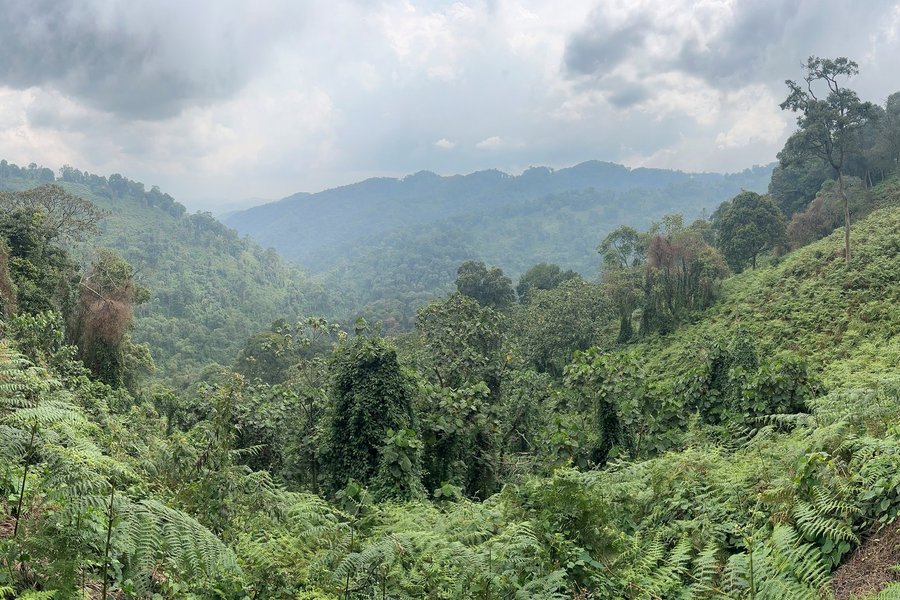
Our Ugandan road trip to Bwindi Impenetrable Forest National Park began in Kampala, taking us via Lake Mburo and Queen Elizabeth National Park, a detour to Rwenzori National Park before reaching the legendary “impenetrable forest” in 6 days.
According to UNESCO, Bwindi is one of the few remaining large expanses of both tropical highland and lowland forest. The highlands feature steep hills and narrow valleys, with altitudes ranging from about 1,200 to 2,600 meters. Its remarkable biodiversity includes many endemic plant species and iconic wildlife such as the greater primates.
This day our group of 6 Norwegians and one South African drove through Queen Elizabeth National Park, heading south along the border with the DR Congo. We made a short stop at QENP southern tip near Ishasha and got an incredible leopard experience. Continuing south, we basically followed the DRC border, through Kihihi and Bulema, then back along the border before turning south again. We entered Bwindi from the northern side, where the map shows a narrow “bottleneck” between the lowland and highland zones near Bugiri. Our route took us through the Ruhija area in the park’s eastern part, continuing south to its southeastern edge, where we exited towards Nyamabale and eventually reached our destination for the day: Chameleon Hills Forest Lodge at Lake Mutanda—after an epic 11½ hours on the road.
The drive was both challenging and breathtakingly scenic. The road winds through steep hills, dense rainforest, and remote villages, revealing misty valleys, lush greenery, and small tea plantations …
Keep reading 0 comments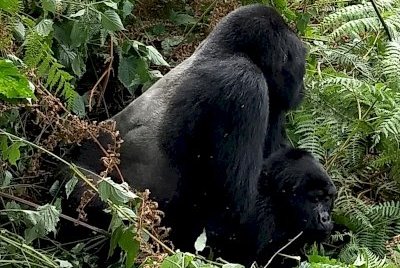
I think "Bwindi Impenetrable Forest" is my favorite park name in the world -- the most evocative of adventure. It lived up to its name and feeling for us with our gorilla trek. We visited to seek gorillas, of course, and had an amazing time. We chose to trek from Buhoma and were assigned to the Mubare group, which has one of the 3 biggest silverbacks in the forest. At around 195 kg, he is very impressive and looks even bigger in person. We hiked about two hours to reach our gorilla group. We started on a trail up one steep ridge past some farms and eventually diving into the forest full of very tall trees. The last part of the hike we had to leave any trail and the rangers were hacking through the thick (and thorny) underbrush with machetes to make a trail for us. The total hike was probably about two hours to reach the gorillas. Our group included the big silverback and 3 mother-baby pairs. As they were all pretty well-secreted in the bush, the rangers had to pull back vines in order for us to see them, and we also got much closer than the usual 7 meters in order to see them in the undergrowth. Our hour with them passed very quickly, but, as a treat, just before our time was up, we got to witness the silverback mating with one of the females. We were just astounded that this happened while we were …
Keep reading 0 comments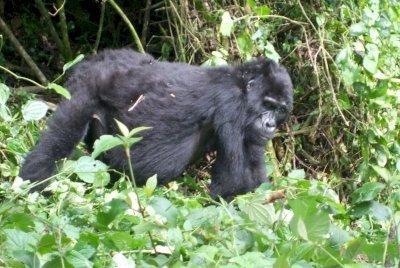
There’s a reason the film wasn’t called Gorillas in the Dazzling Sunshine. My first view of Bwindi Impenetrable Forest was of a wall of foliage climbing the valley wall opposite, wreathed in skeins of spectral blue mist. The knowledge that the following day I would be setting off into the jungle on foot to search for mountain gorillas was thrilling.
I had booked my permit in advance – but not dramatically so. The whole trip to Uganda was fairly last minute and so I had only made my reservation a month ahead of time. There was the risk that all the permits would have been sold out. I was lucky. With hindsight, starting from Buhoma gave me the best chance of getting a place. At the time of my travel there were seven groups of Mountain Gorillas ‘habituated’ to human presence. One is in the southern Mgahinga Gorilla National Park (on the Tentative List) and the other six are located in Bwindi. There are four trailheads. From Ruhija in the east of the park the Bitakura group can be tracked. From Rushaga in the south the Shongi group can be tracked. Els visited Nkuringo in the south west, from where the Nkuringo group can be tracked. And in the north-west, from Buhoma, three groups – Mubare, Rushegura and Habinyanja – can be tracked. Buhoma was therefore ‘Gorilla Central’ and this was where I stayed in some community-run bandas just within the park gates.
When I arrived at …
Keep reading 0 comments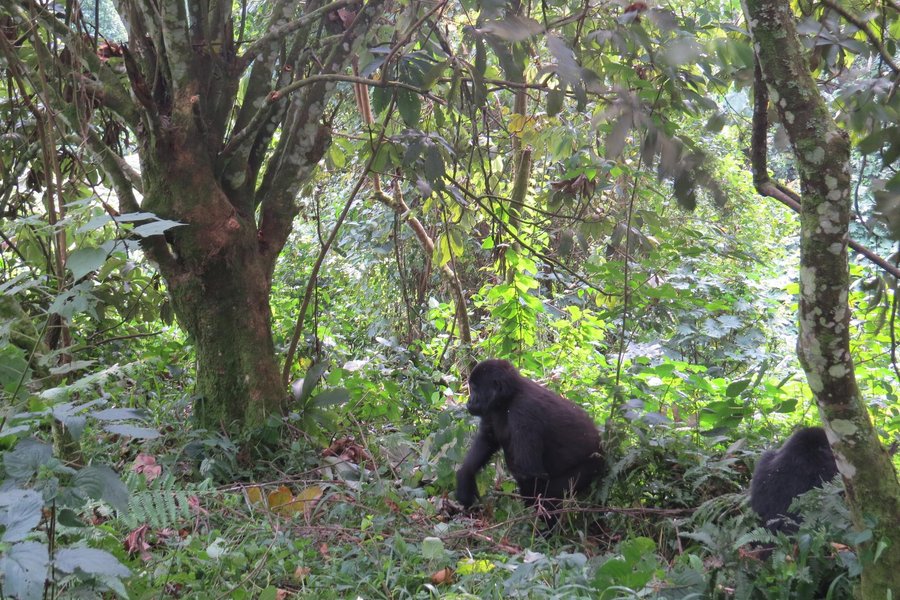
Bwindi Impenetrable National Park has been made a WHS for its high variety of tree and fern species, whose dense cover of the valley floors has led to the name ‘impenetrable’. It is the remnant of what once was a very large forest. To the general public, the park is mostly known as the number 1 place to see mountain gorillas. Bwindi welcomes over 20,000 visitors a year for that purpose.
Although the southern part of Bwindi lies only some 50km north of Mgahinga NP and the Virunga Massif, it is a separate mountain range. Both nature reserves were once connected via a corridor, but they got separated some 500 years ago. The mountain gorillas in Bwindi have evolved on their own since, that’s why they’re sometimes regarded as a different subspecies from the Virunga ones. According to research, they are more likely to feed on fruits, travel longer distances per day and build their nest in trees than their Virungan cousins.
As this was my second gorilla tracking after Virunga 5 days before, it is tempting to compare the two experiences. In hindsight, I am happy that I choose to put two gorilla visits on my schedule. Actually, quite a lot of people do so, often combining Rwanda and Uganda. My two visits complemented each other well: the gorillas in Virunga were extremely calm, just sitting around for 45 minutes so it was easy to take good photos and observe their enormous bodies. The gorillas in Bwindi were very …
Keep reading 0 comments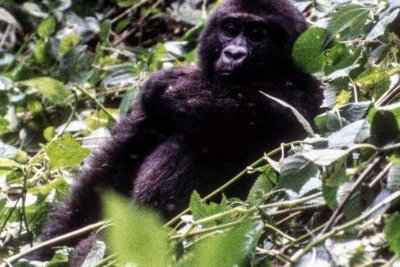
Those who want to see Gorillas in the wild have relatively few choices. In Central Africa, Gabon is a possibility but, in 2001 after 2 days hard tracking there, we had only heard the creatures – they are not well “habituated”. Congo Brazzaville sounds to have some wonderful areas but is dangerous/unhealthy (Ebola?). The Democratic Republic of the Congo (DRC) is, as of Sept 2006 (when this review was written), still not really safe for travel outside Goma. Which leaves Rwanda and Uganda. Rwanda is well back in business and from our experience is the better place to go for anyone just wanting to see Gorillas - it has 7 habituated groups and most of these are usually easy to reach (but the cost is $375 per visit rising in 2007 to $500). However its Gorilla location is somewhat illogically not a UNESCO site - really the neighbouring Gorilla areas within the "Virungas" in all 3 countries (DRC, Uganda and Rwanda) should compromise a single WHS - the Rwanda gorilla sites are just a few kms from the boundary of the Virunga park in DRC.
In Uganda all recent reports suggest that sightings are to all intents and purposes unachievable now at Mgahinga Gorilla Park. Which just leaves Bwindi – which also has the unique advantage of also being a WHS! We visited it way back in summer 1995 - in 1999 the camp we stayed at was to be the site of terrorist attack which resulted in the …
Keep reading 0 comments
